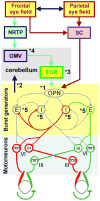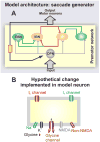Saccadic oscillations - membrane, model, and medicine
- PMID: 25705246
- PMCID: PMC4336148
- DOI: 10.1586/eop.12.55
Saccadic oscillations - membrane, model, and medicine
Abstract
Saccadic oscillations are continuous back-to-back saccades that cause excessive image motion across fovea and threaten clear vision. Acquired processes, related to immune or metabolic mechanisms, are common culprits. Saccadic oscillations are also seen in degenerative cerebellar disease or as a part of a familial syndrome of saccadic oscillations and limb tremor. Some normal individuals have innate ability to voluntarily trigger saccadic oscillations (i.e. voluntary nystagmus). Contemporary theory for the pathogenesis for saccadic oscillations has emphasized hyperexcitable or disinhibited state of the brainstem saccadic burst neuron membrane. This review discusses etiologies and treatment of saccadic oscillations in light of novel cell membrane based theory.
Keywords: computational simulation; genetic; ion channels; opsoclonus; oscillopsia; paraneoplastic; saccade.
Figures


Similar articles
-
Ocular oscillations generated by coupling of brainstem excitatory and inhibitory saccadic burst neurons.Exp Brain Res. 2005 Jan;160(1):89-106. doi: 10.1007/s00221-004-1989-8. Exp Brain Res. 2005. PMID: 15289966
-
Saccadic burst cell membrane dysfunction is responsible for saccadic oscillations.J Neuroophthalmol. 2008 Dec;28(4):329-36. doi: 10.1097/WNO.0b013e31818eb3a5. J Neuroophthalmol. 2008. PMID: 19145136 Free PMC article. Review.
-
Paraneoplastic seesaw nystagmus and opsoclonus provides evidence for hyperexcitable reciprocally innervating mesencephalic network.J Neurol Sci. 2018 Jul 15;390:239-245. doi: 10.1016/j.jns.2018.05.002. Epub 2018 May 3. J Neurol Sci. 2018. PMID: 29801897
-
A new familial disease of saccadic oscillations and limb tremor provides clues to mechanisms of common tremor disorders.Brain. 2007 Nov;130(Pt 11):3020-31. doi: 10.1093/brain/awm240. Epub 2007 Oct 5. Brain. 2007. PMID: 17921180
-
Triggered saccadic oscillations: case series and review of the literature.J Neurol. 2024 Aug;271(8):5622-5628. doi: 10.1007/s00415-024-12533-8. Epub 2024 Jun 25. J Neurol. 2024. PMID: 38916677 Review.
Cited by
-
Saccadic Eye Movement Abnormalities in Children with Epilepsy.PLoS One. 2016 Aug 2;11(8):e0160508. doi: 10.1371/journal.pone.0160508. eCollection 2016. PLoS One. 2016. PMID: 27483011 Free PMC article.
-
Gaze-holding and anti-GAD antibody: prototypic heterogeneous motor dysfunction in immune disease.Cerebellum. 2022 Feb;21(1):55-63. doi: 10.1007/s12311-021-01272-5. Epub 2021 May 11. Cerebellum. 2022. PMID: 33977497
References
-
- Leigh RJ, Zee DS. The Neurology of Eye Movements. Oxford; New York: 2006.
-
- Shaikh AG, Miura K, Optican LM, Ramat S, Leigh RJ, Zee DS. A new familial disease of saccadic oscillations and limb tremor provides clues to mechanisms of common tremor disorders. Brain. 2007;130(Pt 11):3020–3031. Reference describes novel pathophysiology of familial saccadic oscillations. - PubMed
-
- Shaikh AG, Marti S, Tarnutzer AA, et al. Gaze fixation deficits and their implication in ataxia-telangiectasia. J Neurol Neurosurg Psychiatry. 2009;80(8):858–864. - PubMed
-
- Keane JR, Devereaux MW. Opsoclonus associated with an intracranial tumor. A clinicopathologic case report. Arch Ophthalmol. 1974;92(5):443–445. - PubMed
Grants and funding
LinkOut - more resources
Full Text Sources
